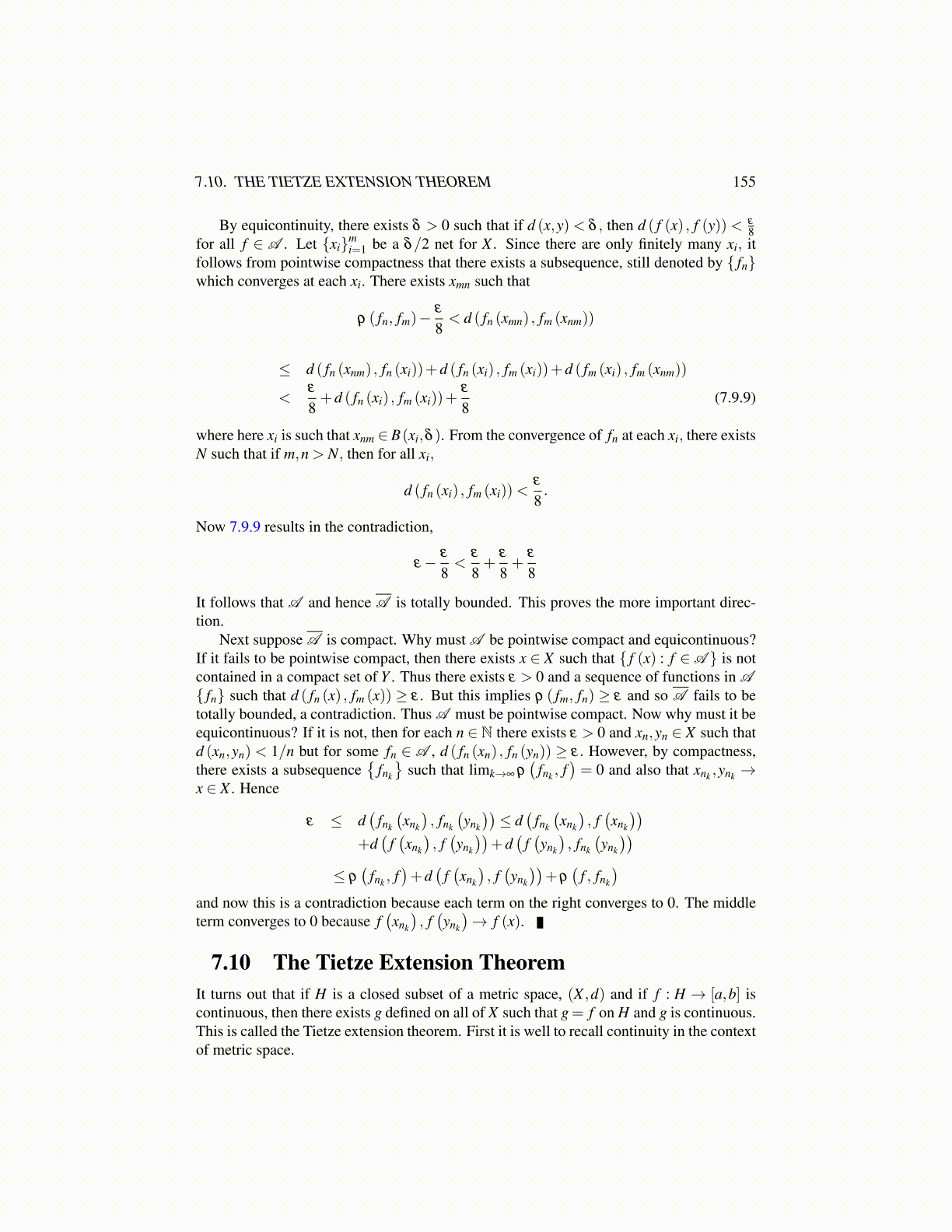
7.10. THE TIETZE EXTENSION THEOREM 155
By equicontinuity, there exists δ > 0 such that if d (x,y) < δ , then d ( f (x) , f (y)) < ε
8for all f ∈ A . Let {xi}m
i=1 be a δ/2 net for X . Since there are only finitely many xi, itfollows from pointwise compactness that there exists a subsequence, still denoted by { fn}which converges at each xi. There exists xmn such that
ρ ( fn, fm)−ε
8< d ( fn (xmn) , fm (xnm))
≤ d ( fn (xnm) , fn (xi))+d ( fn (xi) , fm (xi))+d ( fm (xi) , fm (xnm))
<ε
8+d ( fn (xi) , fm (xi))+
ε
8(7.9.9)
where here xi is such that xnm ∈ B(xi,δ ). From the convergence of fn at each xi, there existsN such that if m,n > N, then for all xi,
d ( fn (xi) , fm (xi))<ε
8.
Now 7.9.9 results in the contradiction,
ε− ε
8<
ε
8+
ε
8+
ε
8
It follows that A and hence A is totally bounded. This proves the more important direc-tion.
Next suppose A is compact. Why must A be pointwise compact and equicontinuous?If it fails to be pointwise compact, then there exists x ∈ X such that { f (x) : f ∈A } is notcontained in a compact set of Y . Thus there exists ε > 0 and a sequence of functions in A{ fn} such that d ( fn (x) , fm (x)) ≥ ε . But this implies ρ ( fm, fn) ≥ ε and so A fails to betotally bounded, a contradiction. Thus A must be pointwise compact. Now why must it beequicontinuous? If it is not, then for each n ∈ N there exists ε > 0 and xn,yn ∈ X such thatd (xn,yn) < 1/n but for some fn ∈ A , d ( fn (xn) , fn (yn)) ≥ ε. However, by compactness,there exists a subsequence
{fnk
}such that limk→∞ ρ
(fnk , f
)= 0 and also that xnk ,ynk →
x ∈ X . Hence
ε ≤ d(
fnk
(xnk
), fnk
(ynk
))≤ d
(fnk
(xnk
), f(xnk
))+d(
f(xnk
), f(ynk
))+d(
f(ynk
), fnk
(ynk
))≤ ρ
(fnk , f
)+d(
f(xnk
), f(ynk
))+ρ
(f , fnk
)and now this is a contradiction because each term on the right converges to 0. The middleterm converges to 0 because f
(xnk
), f(ynk
)→ f (x).
7.10 The Tietze Extension TheoremIt turns out that if H is a closed subset of a metric space, (X ,d) and if f : H → [a,b] iscontinuous, then there exists g defined on all of X such that g = f on H and g is continuous.This is called the Tietze extension theorem. First it is well to recall continuity in the contextof metric space.